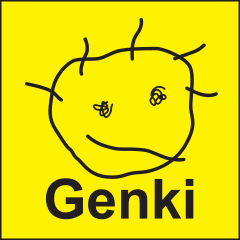Difference between revisions of "Genki"
From Sega Retro
Scarred Sun (talk | contribs) m |
|||
| (23 intermediate revisions by 7 users not shown) | |||
| Line 1: | Line 1: | ||
| − | {{ | + | {{CompanyBob |
| − | | logo=Genki logo. | + | | logo=Genki logo.svg |
| − | + | | founded=1990-10 | |
| − | | founded= | ||
| defunct= | | defunct= | ||
| tseries=T-308 | | tseries=T-308 | ||
| − | |||
| − | |||
| headquarters=Shinjuku-ku, Tokyo, Japan | | headquarters=Shinjuku-ku, Tokyo, Japan | ||
}} | }} | ||
| − | |||
| − | + | '''Genki''' (元気) is a Japanese developer of computer and video games. It was founded in October 1990 by [[Hiroshi Hamagaki]] and [[Tomo Kimura]], who left [[Sega]] to form the company. Genki's logo is a picture of Hiroshi Hamagaki, drawn by his son when he was 3 years old. | |
| − | + | In its early years, Genki dabbled in a few different genres, looking for its niche. The company made efforts in several directions: puzzle game ''[[Devilish]]'' for the [[Game Gear]], as well as a first-person mecha shooter, ''Kileak: The DNA Imperative'', for the [[PlayStation]], and the role-playing game ''Jade Cocoon'' for the same system. Although they did not know it at the time, Genki found its niche in 1994, with the release of ''Shutokō Battle '94 Keichii Tsuchiya Drift King'' for the Super Famicom—the first in a long-running series of racing games. | |
| + | Within the same year, Genki shifted towards developing 3D games, continuing the Shutokou Battle series with ''Wangan Dead Heat'' (known in Western markets as ''[[Highway 2000]]'') on the [[Sega Saturn]]. Genki also produced major titles for both the PlayStation and [[Nintendo|Nintendo's]] [[N64]] console in the following two years, including another Shutokou Battle game for the PlayStation (known in western markets as "Tokyo Highway Battle") and Multi-Racing Championship for the N64. | ||
| + | |||
| + | Genki continued the Shutokou Battle series, releasing a title for the [[Dreamcast]] console in 1999, simply called ''Shutokou Battle.'' This game was also exported to Western markets, where it came to be known as ''[[Tokyo Xtreme Racer]]'' (U.S.) and''Tokyo Highway Challenge'' (Europe). The Dreamcast version of ''Shutokou Battle'' enjoyed much greater success than any of its predecessors, and was soon followed up by ''[[Tokyo Xtreme Racer 2|Shutokou Battle 2]]''. | ||
==Softography== | ==Softography== | ||
| − | {{ | + | {{CompanyHistoryAll|Genki}} |
| − | | | ||
| − | |||
| − | |||
| − | == | + | ==External links== |
| − | + | [http://www.genki.co.jp/ Offical website] | |
| − | |||
| − | |||
| − | |||
| − | |||
| − | |||
| − | |||
| − | |||
| − | |||
| − | |||
| − | |||
| − | |||
| − | + | ==References== | |
| + | <references /> | ||
Latest revision as of 09:21, 18 December 2023

| ||
| Genki | ||
|---|---|---|
| Founded: 1990-10 | ||
| T-series code: T-308 | ||
Headquarters:
|
Genki (元気) is a Japanese developer of computer and video games. It was founded in October 1990 by Hiroshi Hamagaki and Tomo Kimura, who left Sega to form the company. Genki's logo is a picture of Hiroshi Hamagaki, drawn by his son when he was 3 years old.
In its early years, Genki dabbled in a few different genres, looking for its niche. The company made efforts in several directions: puzzle game Devilish for the Game Gear, as well as a first-person mecha shooter, Kileak: The DNA Imperative, for the PlayStation, and the role-playing game Jade Cocoon for the same system. Although they did not know it at the time, Genki found its niche in 1994, with the release of Shutokō Battle '94 Keichii Tsuchiya Drift King for the Super Famicom—the first in a long-running series of racing games.
Within the same year, Genki shifted towards developing 3D games, continuing the Shutokou Battle series with Wangan Dead Heat (known in Western markets as Highway 2000) on the Sega Saturn. Genki also produced major titles for both the PlayStation and Nintendo's N64 console in the following two years, including another Shutokou Battle game for the PlayStation (known in western markets as "Tokyo Highway Battle") and Multi-Racing Championship for the N64.
Genki continued the Shutokou Battle series, releasing a title for the Dreamcast console in 1999, simply called Shutokou Battle. This game was also exported to Western markets, where it came to be known as Tokyo Xtreme Racer (U.S.) andTokyo Highway Challenge (Europe). The Dreamcast version of Shutokou Battle enjoyed much greater success than any of its predecessors, and was soon followed up by Shutokou Battle 2.
Contents
Softography
Mega Drive
- Metal Fangs (1993)
Game Gear
- Devilish (1991)
Mega-CD
- A/X-101 (1994)
- Metal Fang (unreleased)
Saturn
- Robotica: Cybernation Revolt (1995)
- Hang-On GP (1995)
- Highway 2000 (1995) (production)
- Wangan Dead Heat + Real Arrange (1996)
- Fist (1996)
- Shutokou Battle '97: Tsuchiya Keiichi & Bandou Masaaki Mihonhin (1997)
- Shutokou Battle '97: Tsuchiya Keiichi & Bandou Masaaki (1997)
- Shutsudou! Miniskirt Police (1997)
- Initial D: Koudou Saisoku Densetsu (1998)
Dreamcast
- Virtua Fighter 3tb (1998)
- Shutokou Battle Taikenban (1999)
- Super Magnetic Niu Niu Promotion Disc (1999)
- Tokyo Xtreme Racer (1999)
- Virtua Striker 2 Ver. 2000.1 (1999)
- Shutokou Battle 2 Taikenban (2000)
- Super Magnetic Neo Demo CD (2000)
- Super Magnetic Neo (2000)
- Tokyo Xtreme Racer 2 (2000)
- Daytona USA 2001 (2000)
Nintendo DS
- Black Jack: Hi no Tori Hen (2006)
PlayStation 3
Wii U